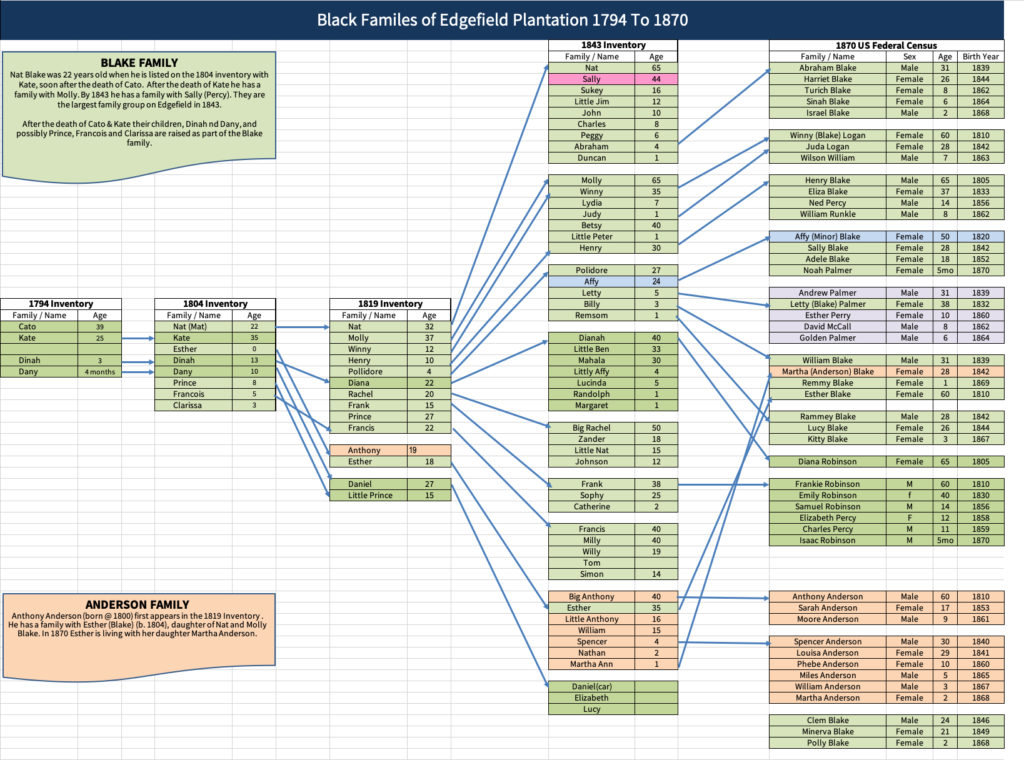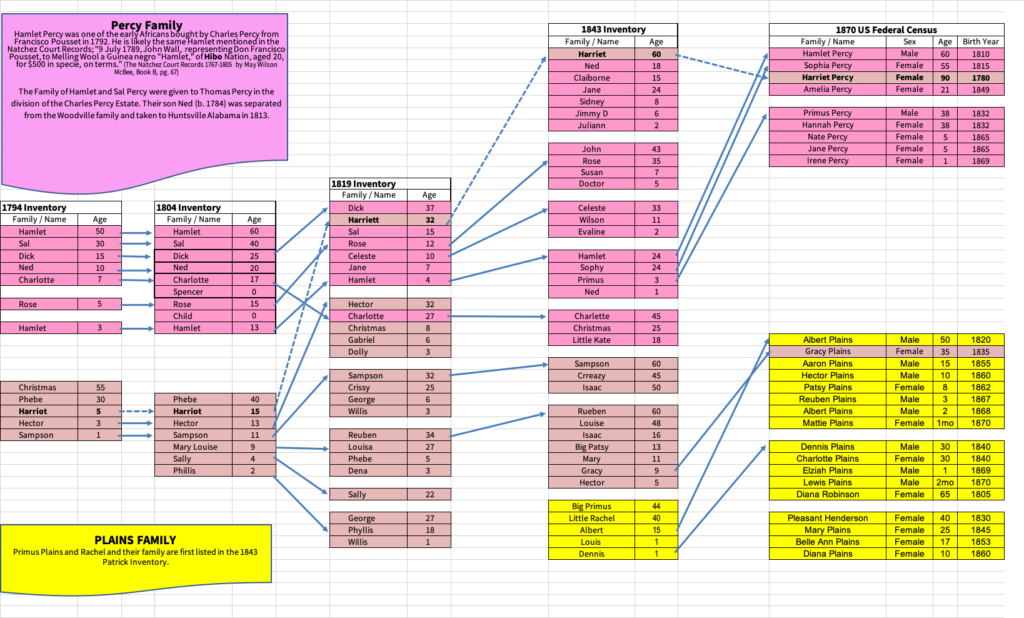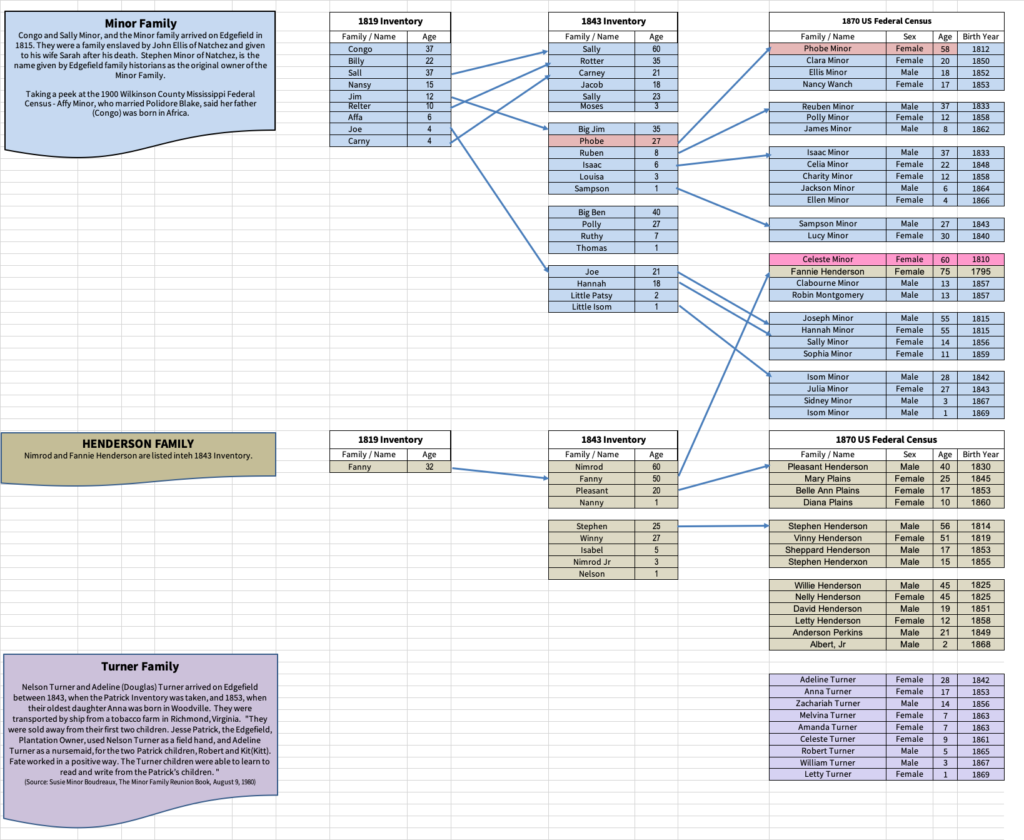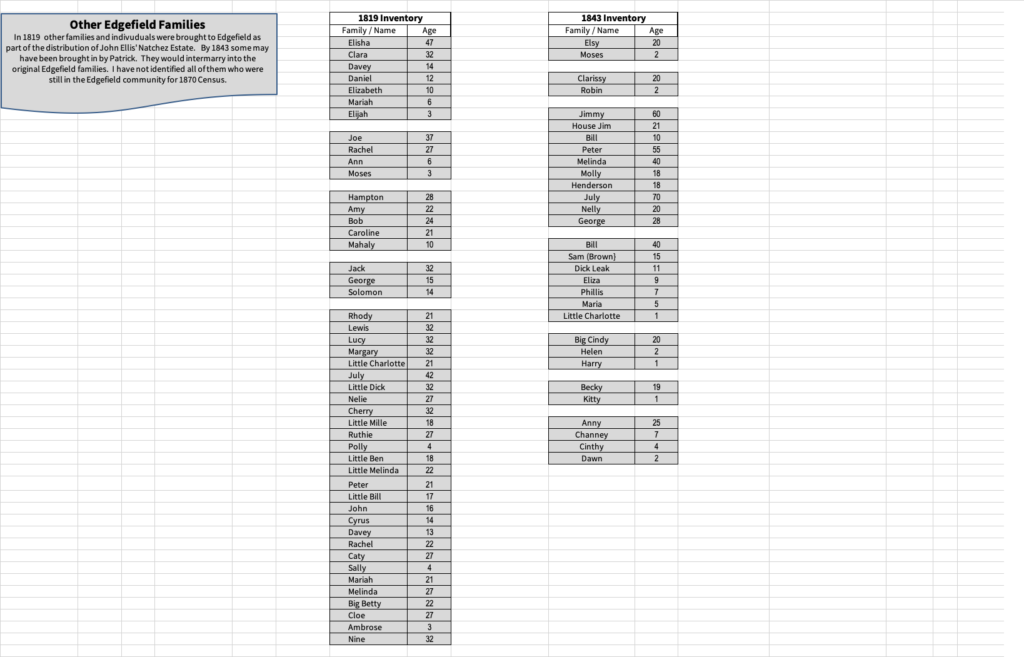Part 9. The Edgefield Community 1870 Census – Following Harriett
(Dedicated to “Mama Mack” ~ Eva Partee McMillan May 7, 1921 – September 23, 2021)
By 1870, the earliest Black Families had been in the Edgefield Community for almost one-hundred years. Although the owners of the plantation changed every 10 to 20 years, the families remained in the same location. After the Civil War and Emancipation, many of the Edgefield families left Woodville to find work or they married and went to live near their spouses’ family in other parts of town.
The 1870 Census was the first U.S. Mississippi Population Census that recorded the formerly enslaved Edgefield community by their full names, age, sex, and color – White (W), Black (B), Mulatto (M), Chinese (C), Indian (I). In addition, it recorded the person’s occupation, value of real estate and personal estate owned, and the state they were born in.

Now I will compare the names listed in the 1870 census to the 1843 J.C. Patrick inventory of enslaved persons – twenty-seven years earlier, and compare the names to the first inventory taken in the 1794 estate of Charles Percy.
Shoutout to my Edgefield cousins – if you can now see your family names let me know. If your family was on Edgefield before 1870 and is missing, let me know – or just find them.
Now, I will show who these families are.




The family of Hamlet was the only family that chose the last name Percy. Hamlet was one of the early Africans bought by Charles Percy from Francisco Pousset in 1792. Hamlet and his family may have chosen the Percy name because this was the first plantation owner he encountered in the United States.
The other families had previous owners and kept the last names of owners as signposts to remember their families left back in Kentucky, Virginia, North and South Carolina. None of the other families chose the Woodville plantation owners’ names – Percy, Ellis, Ware, Connell, or Patrick, as a last name. Instead, they chose Blake, Minor, Anderson, Plains and Henderson. All names that came from someplace else.
At the time of Emancipation in 1865, no one on Edgefield owned real estate or personal property. The families that chose to remain and work on Edgefield, now run by Patrick’s wife Eliza, and later her son Robert, all are farm laborers or housekeepers with a few exceptions. Winny (Blake) Logan and Lucy Minor are domestic servants which means they worked outside of their own home. Frank Roberson’s occupation was tending stock. Only two individuals had personal property by 1870. Abraham Blake was a blacksmith who had accumulated $220, and Sampson Minor was a farm laborer who had accumulated $100.
These families lived their entire life on Edgefield. In the 1870 census, most of them stated they were born in Mississippi. The Turners were shipped by J. C. Patrick from Richmond Virginia and brought into Woodville in around 1847.There are five people in the Edgefield community on the 1870 Census who said they were born in Kentucky, although the inventories show they were born on Edgefield. More than likely, there is a connection to Kentucky, especially in the descendants of Cato and Kate that I will have to investigate.
Following Harriett …the North Star
Over 20 years ago, I began to assemble the history of the Black Families of Edgefield Plantation. The 1794 Will of Charles Percy was one of the first documents that I found. The list of enslaved persons on the Will includes Harriett, the 5-year-old daughter of Christmas and Phebe. Harriett, born in 1789, was later married to Dick, the oldest son of Hamlet and Sal Percy. After years of finding and sorting through lists of names on documents and trying to connect the dots, I noticed Harriett Percy, a 90-year-old female, was on the 1870 Census. At that point I knew it was the same Harriett, enslaved on the Edgefield plantation for 76 years. That is also when I felt certain I could trace the community of families using the earliest records and identify them by family names in 1870. This methodology of identifying Edgefield plantation communities and families using the family oral history, and finding the earliest enslavement records, and comparing to the family names in the 1870 Census, is what I call Following Harriett!
Next: Part 10 (Final) The Black Families of Edgefield – A 100 Year History

Alvin,
Please keep this blog going because love how you are able to trace the ancestors.
Thanks Marlene.
Fascinating research. What’s next after you publish part 10?
Thanks Gerri. In Part 10 I will write a preview of an upcoming series on Wilkinson County MS Reconstruction in 1876. After Part 10 I will write a few blogs on a mix of new topics. Thanks for asking.
Thanks for sharing your research with us. I have enjoyed every post and learned so much. Your “Telling of the story” encourages all of us to continue our own pursuit of our family histories.
Thanks Earline. I hope you can take advantage of the Wilkinson County resources that I have identified.
Great read. I was waiting on Nat lol
Thanks for reading Marlon.
I missed this one – love the tables that connect the dots from the slave inventories to the census document. I hope your family recognizes the incredible gift you’ve given them. They are fortunate to have you!
Thanks Sherre. The response from my family has been very good. I have told them I am writing for future generations.
Yes good beautiful work blessings

Thanks for reading.
Oh My! Thank you for all of your hard work, it is appreciated. Family history!
Thanks for reading Antoinette. Please subscribe to my blog.